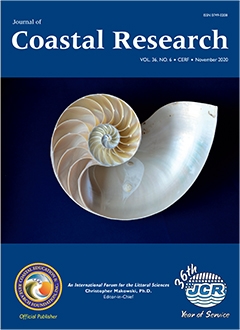Wang, H.; Li, W.; Zuo, C.; Dong, J.; Li, C.; Xu, H.; Liu, Q., and Pan, S., 2020. Saltwater intrusion in the Pearl River estuary (China): Variation characteristics and cause analysis. Journal of Coastal Research, 36(6), 1145–1153. Coconut Creek (Florida), ISSN 0749-0208.
The characteristics and influence factors of saltwater intrusions in the Pearl River Estuary were analyzed with tide gauge observation data, sea-level rise impact investigation data, and discharge data. The results show that (1) Seasonal variations in saltwater intrusion in the Pearl River estuary are obvious. Intrusion usually begins in September–October and ends in March–April of the following year. More saltwater is present in January, February, and October, which all had more than 10 events in the last 10 years. The number of saltwater intrusions fluctuated during 2009–2018, with the highest number of 14 in 2010 and the lowest of 2 in 2015. The annual saltwater intrusion duration increased obviously during 2015–2018 and lasted 171 days in 2018. (2) The integrated influence factor of sea level and discharge is closely related to frequency and duration of saltwater occurrence, with correlation coefficients of 0.7 and 0.5, respectively (95% confidence). From January to March, the Pearl River is in the dry season, and the integrated influence factor of sea level and discharge is positive, corresponding to more saltwater intrusions. From April to August, the seasonal sea level is low and discharge is high, resulting in a negative integrated influence factor of sea level and discharge and nearly no saltwater intrusion. From September to December, the seasonal sea level is high and the discharge is low. The integrated influence factor of sea level and discharge is higher than 1, corresponding to the high occurrence of saltwater intrusions. (3) Astronomical high tides mostly occur during return tides. The combination of astronomical tides and storm surges aggravates saltwater intrusions and their influence. (4) Countermeasures, including saltwater monitoring and forecasting, river basin management, and water conservation, are suggested to effectively address saltwater intrusion.





